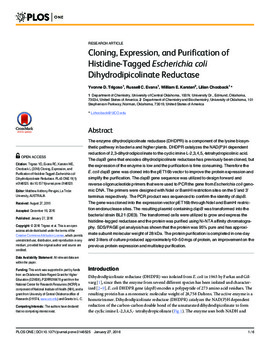| dc.contributor.author | Yvonne D. Trigoso | |
| dc.contributor.author | Russell C. Evans | |
| dc.contributor.author | William E. Karsten | |
| dc.contributor.author | Lilian Chooback | |
| dc.date.accessioned | 2017-03-04T01:59:52Z | |
| dc.date.available | 2017-03-04T01:59:52Z | |
| dc.date.issued | 2016-01-27 | |
| dc.identifier.citation | Trigoso YD, Evans RC, Karsten WE, Chooback L (2016) Cloning, Expression, and Purification of Histidine-Tagged Escherichia coli Dihydrodipicolinate Reductase. PLoS ONE 11(1): e0146525. doi:10.1371/journal.pone.0146525 | en_US |
| dc.identifier.uri | https://hdl.handle.net/11244/49232 | |
| dc.description | This work was supported in part by funds from an Oklahoma State Regent Grant for Higher Education (021606), P20RR016478 grant from the National Center for Research Resources (NCRR) a component of National Institute of Health (NIH), and a grant from the University of Central Oklahoma office of Research and Grants to L.C. | en_US |
| dc.description | | en_US |
| dc.description.abstract | The enzyme dihydrodipicolinate reductase (DHDPR) is a component of the lysine biosynthetic pathway in bacteria and higher plants. DHDPR catalyzes the NAD(P)H dependent reduction of 2,3-dihydrodipicolinate to the cyclic imine L-2,3,4,5,-tetrahydropicolinic acid. The dapB gene that encodes dihydrodipicolinate reductase has previously been cloned, but the expression of the enzyme is low and the purification is time consuming. Therefore the E. coli dapB gene was cloned into the pET16b vector to improve the protein expression and simplify the purification. The dapB gene sequence was utilized to design forward and reverse oligonucleotide primers that were used to PCR the gene from Escherichia coli genomic DNA. The primers were designed with NdeI or BamHI restriction sites on the 5’and 3’ terminus respectively. The PCR product was sequenced to confirm the identity of dapB. The gene was cloned into the expression vector pET16b through NdeI and BamHI restriction endonuclease sites. The resulting plasmid containing dapB was transformed into the bacterial strain BL21 (DE3). The transformed cells were utilized to grow and express the histidine-tagged reductase and the protein was purified using Ni-NTA affinity chromatography. SDS/PAGE gel analysis has shown that the protein was 95% pure and has approximate subunit molecular weight of 28 kDa. The protein purification is completed in one day and 3 liters of culture produced approximately 40–50 mgs of protein, an improvement on the previous protein expression and multistep purification. | en_US |
| dc.language.iso | en_US | en_US |
| dc.publisher | PLos One | |
| dc.relation.ispartofseries | PLoS ONE 11(1): e0146525 | |
| dc.relation.uri | http://www.plosone.org/article/info%3Adoi%2F10.1371%2Fjournal.pone.0146525 | |
| dc.rights | Attribution 3.0 United States | |
| dc.rights.uri | https://creativecommons.org/licenses/by/3.0/us/ | |
| dc.subject | Histidine,Polymerase chain reaction,Cloning,Plasmid construction,Lysis (medicine),Protein expression,Vector cloning,DNA isolation | en_US |
| dc.title | Cloning, Expression, and Purification of Histidine-Tagged Escherichia coli Dihydrodipicolinate Reductase | en_US |
| dc.type | Research Article | en_US |
| dc.description.peerreview | Yes | en_US |
| dc.description.peerreviewnotes | http://www.plosone.org/static/editorial#peer | en_US |
| dc.identifier.doi | 10.1371/journal.pone.0146525 | en_US |
| dc.rights.requestable | false | en_US |

